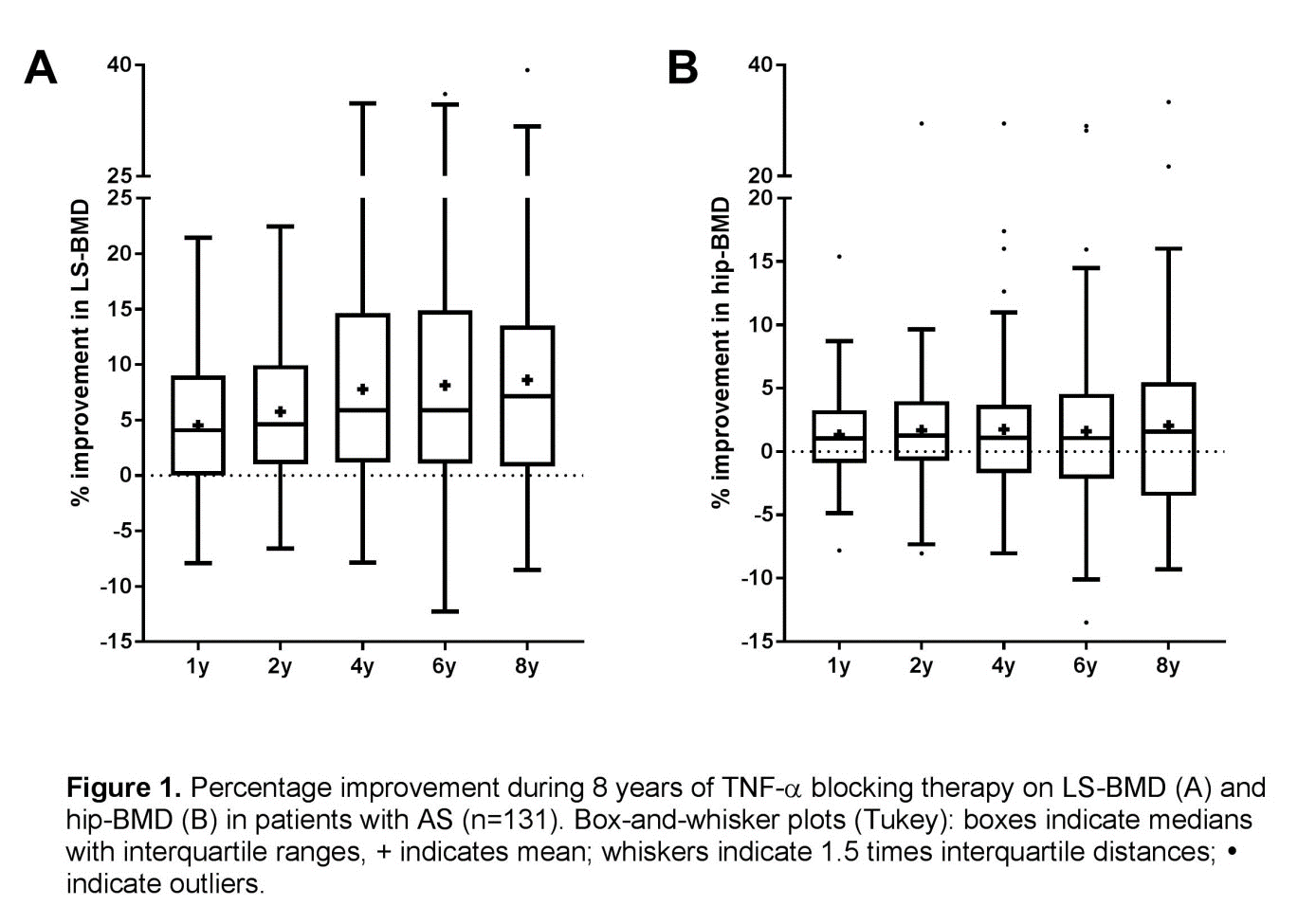Session Information
Date: Saturday, November 12, 2022
Title: Spondyloarthritis Including PsA – Treatment Poster I: AxSpA
Session Type: Poster Session A
Session Time: 1:00PM-3:00PM
Background/Purpose: Bone loss reflected by lower bone mineral density (BMD) compared to age and gender matched healthy controls is a common feature of ankylosing spondylitis (AS) and can already be observed at early stages of the disease1. AS patients starting TNF-α inhibitors (TNFi) show overall a rapid increase in BMD2. However, the course of BMD during long-term TNFi in these patients is not known. The objective of this study was to assess the course of BMD of the lumbar spine (LS) and hip in AS patients treated with TNFi during 8 years.
Methods: Patients from the GLAS cohort who received TNFi for at least 8 years were included. Patients were excluded when they used bisphosphonates. BMD of the LS (AP projection L1-L4) and hip (total proximal femur) was measured at baseline, 1 year, 2 years and then bi-annually using DEXA. Low BMD was defined as LS and/or hip BMD Z-score ≤1. Generalized estimating equations were used to analyze BMD Z-scores over time within subjects.
Results: 131 AS patients were included; 73% were male, mean ± SD age was 41.3 ± 10.8 years, median (IQR) symptom duration was 14 (7-24) years, 83% were HLA-B27+, mean ASDAScrp was 3.8 ± 0.8, median CRP level was 13 (6-22) mg/L, and median vitamin 25(OH)D3 was 61 (46-80) nmol/L at baseline. Disease activity showed rapid and sustained during TNFi treatment, with mean ASDAScrp of 2.1 ± 0.9 and median CRP of 2 (2-5) at 8 years. Serum levels of vitamin D remained stable, with median vitamin 25(OH)D3 of 60 (47-81) at 8 years.
At baseline, mean LS and hip BMD Z-scores were -0.37 ± 1.08 and -0.05 ± 1.04, respectively. Low BMD at the LS and hip (Z-score ≤1) was present in 34% and 19% of patients, respectively. Overall, both LS and hip BMD Z-scores improved significantly during TNFi at all follow-up visits compared to baseline. Significant improvement of BMD Z-scores compared to the previous time point was found up to and including 4 years for LS and up to and including 2 years for hip. Thereafter, deflection of improvement was observed. Median percentage of improvement in absolute BMD after 8 years of TNFi compared to baseline was 7.1% (IQR 0.8-13.5) for LS and 1.6% (IQR -3.5-5.5) for hip (Figure 1). At 8 years, low BMD at the LS and hip (Z-score ≤1) was present in 23% and 19% of patients, respectively.
Conclusion: In AS patients treated long-term with TNFi, both hip and LS BMD significantly increased especially during the first 2-4 year of treatment and stabilized thereafter. This effect was most pronounced in the LS and small in the hip.
References:
1: Van der Weijden et al. Clin Rheumatol. 2012 Nov ;31(11) :1529-35
2: Arends et al. Arthritis Res Ther. 2012;14(2):R98
To cite this abstract in AMA style:
Siderius M, Spoorenberg A, Wink F, Arends S. The Course of Bone Mineral Density During 8 Years of Treatment with TNF-α Inhibitors in Patients with Ankylosing Spondylitis [abstract]. Arthritis Rheumatol. 2022; 74 (suppl 9). https://acrabstracts.org/abstract/the-course-of-bone-mineral-density-during-8-years-of-treatment-with-tnf-%ce%b1-inhibitors-in-patients-with-ankylosing-spondylitis/. Accessed .« Back to ACR Convergence 2022
ACR Meeting Abstracts - https://acrabstracts.org/abstract/the-course-of-bone-mineral-density-during-8-years-of-treatment-with-tnf-%ce%b1-inhibitors-in-patients-with-ankylosing-spondylitis/

